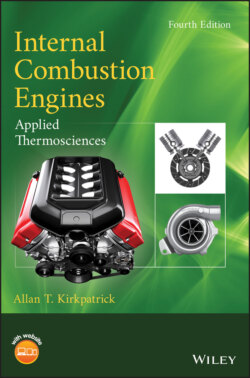Читать книгу Internal Combustion Engines - Allan T. Kirkpatrick - Страница 32
Superchargers and Turbochargers
ОглавлениеAll the engines discussed so far are naturally aspirated, i.e., as the intake gas is drawn in by the downward motion of the piston. Engines can also be supercharged or turbocharged. Supercharging is mechanical compression of the inlet air to a pressure higher than standard atmosphere by a compressor powered by the crankshaft. The compressor increases the density of the intake air so that more fuel and air can be delivered to the cylinder to increase the power. The concept of turbocharging is illustrated in Figure 1.16. Exhaust gas leaving an engine is further expanded through a turbine that drives a compressor. The benefits are twofold: (1) the engine is more efficient because energy that would have otherwise been wasted is recovered from the exhaust gas; and (2) a smaller engine can be constructed to produce a given power because it is more efficient and because the density of the incoming charge is greater. The power available to drive the compressor when turbocharging is a nonlinear function of engine speed such that at low speeds there is little, if any, boost (density increase), whereas at high speeds the boost is maximum. It is also low at part throttle and high at wide‐open throttle. These are desirable characteristics for an automotive engine since throttling or pumping losses are minimized. Most large and medium‐size diesel engines are turbocharged to increase their efficiency. With the anticipated adoption of 48V electrical systems in vehicles, there will be increased use of electrically powered superchargers used in conjunction with a turbocharger to reduce ”turbo lag.”
Figure 1.16 Turbocharger schematic. (Courtesy of Schwitzer.)
